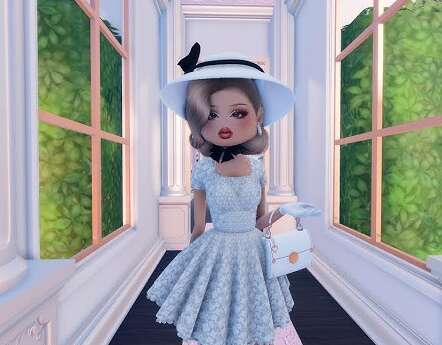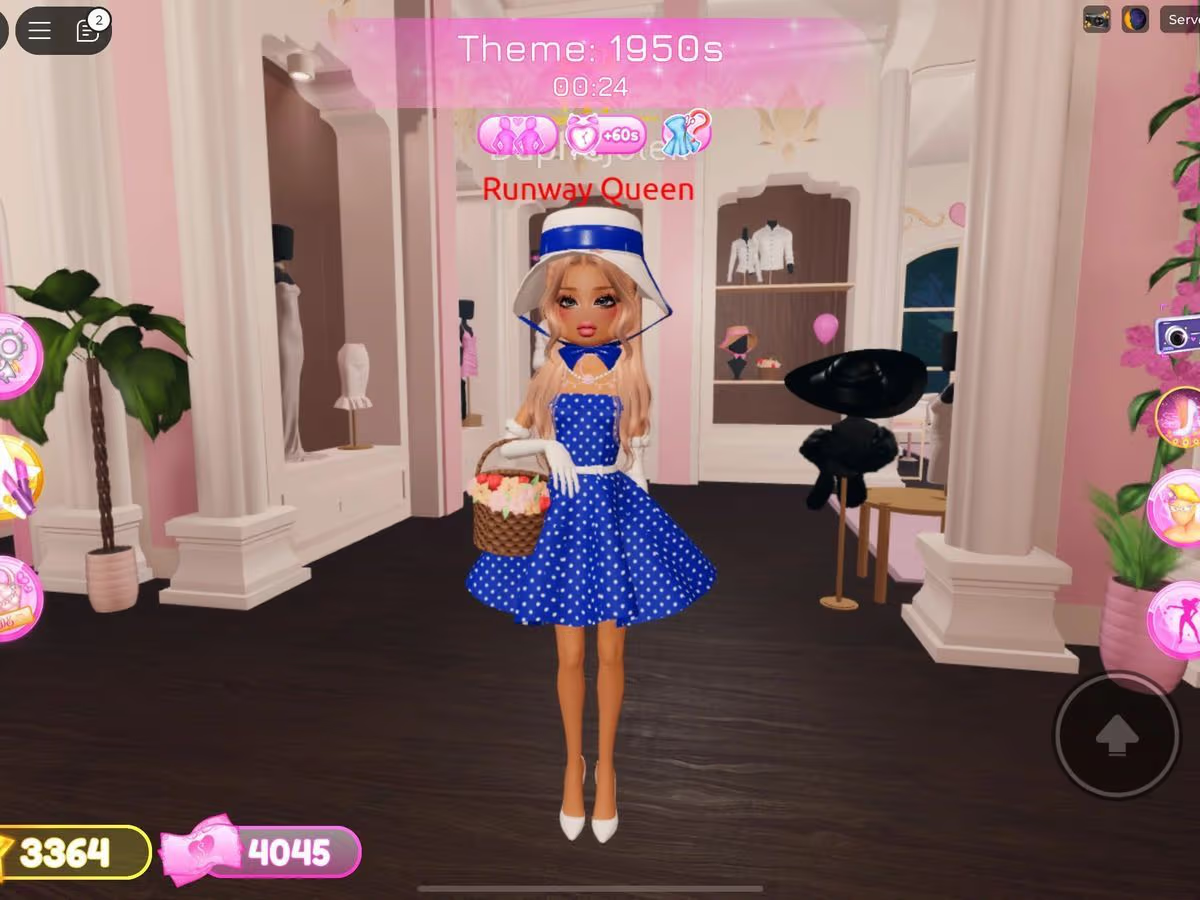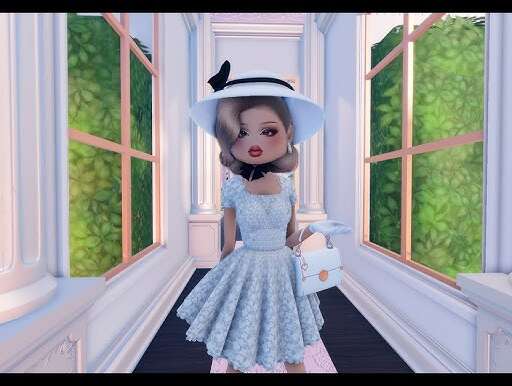The 1950s dress to impress theme represents a golden age when fashion embodied elegance, sophistication, and timeless charm. Fashion evolved into a more refined form after World War II. Designers created dresses that highlighted the body’s natural shape through cinched waists, full skirts, and polished tailoring. Iconic styles emerged during this decade, including poodle skirts, pencil dresses, and swing dresses that made bold yet elegant statements.
The 1950s theme shines brightly among 362 dress to impress themes available in 2025. Its distinctive retro looks and vintage charm continue to captivate fashion enthusiasts today. This piece guides you through everything you need to become skilled at creating this beloved esthetic. You’ll learn about selecting perfect dress shapes and patterns, and discover how to enhance your look with period-appropriate accessories, hairstyles, and makeup.

Table of Contents
- 1 Understand the 1950s Dress to Impress Theme
- 2 Start with the Right Dress Shape
- 3 Play with Patterns, Colors, and Textures
- 4 Add Accessories That Complete the Look
- 5 Hair, Makeup, and Shoes for the Full Effect
- 6 Modern Twists and Outfit Ideas to Try
- 7 Summing all up
- 8 Here are some FAQs about 1950s dress to impress:
- 8.1 How to dress 1950’s style?
- 8.2 What do I wear to a 50’s themed party?
- 8.3 What is decora in a dress to impress?
- 8.4 How to tell if a dress is 1950s?
- 8.5 What clothing was popular in the 1950s?
- 8.6 What are 1950s style dresses called?
- 8.7 What to wear to a 50’s dance?
- 8.8 How to look stylish in the 50s?
- 8.9 What were the popular dress colors in the 50s?
Understand the 1950s Dress to Impress Theme
The 1950s brought a remarkable change in fashion history. Refined elegance replaced practical wartime clothing. This era created a timeless style template that defines what we now call the ultimate “dress to impress” look.
What made 1950s fashion iconic
The post-World War II period ushered in a golden age of fashion. Elegant silhouettes, bold femininity, and precise tailoring defined this remarkable time. Christian Dior revolutionized women’s fashion with his “New Look” in 1947, which set the tone through the early-to-mid 1950s. This signature style celebrated the end of wartime restrictions and welcomed decorative femininity.
Men and women’s fashion took different paths in the 1950s. Women’s clothing emphasized elegance, formality, and perfectly coordinated accessories. Men’s styles became more relaxed for everyday wear. The decade stood out because it offered multiple stylish choices instead of one dominant look. Women looked equally fashionable in full or narrow skirts.
Movie stars played a vital role in making these styles popular. Marilyn Monroe championed curve-enhancing fashions. Audrey Hepburn made casual chic famous with her boat-necked tops and slim pants.
Popular silhouettes and fabrics
Women’s fashion featured two main silhouettes. The full swing skirt with cinched waist created the classic hourglass shape, often with petticoats for extra volume. The sleek pencil or “wiggle” dress showed off curves from waist to mid-calf.
Popular dress styles included shirtwaist dresses that looked great on housewives and movie stars. A-line dresses and sophisticated cocktail dresses bridged the gap between day and evening wear. Strapless bodices became more accessible, especially among teens heading to prom.
Fabrics came in many varieties. Cotton dominated leisure wear. Wool and linen remained favorites for daytime clothes, along with new synthetics like rayon and polyester. Colors ranged from soft pastels to rich jewel tones – royal purple, ruby red, and emerald green. Patterns added personality with polka dots, gingham checks, florals, and fun novelty prints.
Why it fits the Dress to Impress theme
The 1950s approach to “dress to impress” celebrated femininity through confidence, poise, and attention to detail. Every element showed the skill of getting dressed, unlike today’s casual styles. Women maintained their best appearance at home and in public.
This decade’s fashion philosophy shows how to dress impressively through structured, feminine silhouettes that work for many occasions. Full-skirted swing dresses highlight the waist playfully. Form-fitting pencil styles showcase curves. These 1950s fashions flatter various body types beautifully.
The era’s distinctive look combines fitted waists, elegant proportions, and carefully chosen accessories. This style continues to inspire modern dress to impress themes in fashion, entertainment, and social media.
Start with the Right Dress Shape
The right silhouette is vital to create an authentic 1950s dress to impress look. This decade brought unique dress shapes that shaped women’s fashion and still inspire modern designs today.
Full skirts and swing dresses
The signature 1950s look featured full, flowing skirts that moved dramatically with each step. These iconic swing dresses highlighted small waists and flared out with flair, often with petticoats adding extra volume. Traditional swing skirts reached tea length, though modern versions often stop above the knee. Full-skirted dresses remained popular throughout the decade and became more glamorous with extra details for formal events.
Women who want an authentic 1950s look should search for dresses with gathered or pleated fabric that needs up to 6 yards of light material. These styles created the desired hourglass figure that became the symbol of feminine grace during that era.
Pencil dresses and sheath styles
Pencil dresses, also known as wiggle or sheath dresses, stood in stark contrast. These curve-hugging styles showed off a woman’s shape from bust to mid-calf. Real 1950s pencil dresses weren’t too tight but rather slim-fitting, with a vent or kick-pleat in the back that made walking easier.
These dresses usually had high necklines (mostly scoop or boat-neck), fitted bodices, and cap, short, or elbow-length sleeves. Small collars and bows often decorated the bodices, while the skirts featured welt pockets or large patch pockets. This refined style zipped up the back and created what we now call the classic “Mad Men” look.
A-line and shirtwaist dresses
The shirtwaist dress became the 1950s housewife’s unofficial uniform and maybe even the most recognizable everyday fashion piece. This adaptable style mixed a fitted button-down top that looked like a blouse with a gathered or pleated skirt. Christian Dior’s groundbreaking “New Look” collection in 1947 made these dresses popular, featuring the decade’s signature cinched waist.
A-line skirts flared just enough to hang loose over the hips while keeping a clean line. The shirtwaist sleeves came in cap, short or elbow length, with some winter versions having full-length sleeves. People loved this style because it was practical – simple to wear, wash, and move in – while staying feminine.
The right silhouette is your first step toward authentic vintage glamor when you plan your 1950s dress to impress outfit.
Play with Patterns, Colors, and Textures
The magic of 1950s patterns, colors, and textures brings a dress to impress outfit to life after selecting the perfect silhouette. Post-war optimism filled fashion with vibrant visual elements that remain uniquely “fifties” today.
Polka dots, florals, and gingham
Pattern selection plays a vital role in creating an authentic 1950s dress to impress look. Polka dots dominated the decade. Large and small dots decorated dresses of every style. These playful circles became popular with teenagers in the 1940s before becoming a 1950s staple. Black and white polka dots offer timeless appeal for an iconic 1950s theme. Navy blue and red combinations provide interesting alternatives.
Floral prints went through a dramatic transformation during this era. The 1950s florals made bold statements with oversized blooms and handpainted effects, unlike the delicate, small patterns from earlier decades. These large-scale designs appeared on casual day dresses and elegant evening wear. They often featured tropical leaves and animal motifs that added visual interest.
Gingham checks emerged as another signature pattern, especially in pastel colors. These cheerful checks brought youthful charm to westernwear and children’s clothing in spring and summer collections. Border prints, travel themes with Mexican, Caribbean, or nautical motifs, and whimsical novelty prints featuring cherries or flamingos gave more options to create authentic 1950s style.
Bold vs pastel color palettes
The 1950s featured two distinct color approaches based on season and occasion. Light pink, powder blue, cream, aqua, rose, maize (yellow), lilac, and kelly green reflected youthful exuberance in spring and summer. Dark brown, rust, black, charcoal gray, red, royal blue, wine, olive, purple, peacock, gold, and navy dominated fall and winter.
The 1950s dress to impress themes showcased saturated colors that made bold statements, unlike today’s subdued palettes. Black, red, green, and blue topped the color priorities, though pastels gained popularity as the decade progressed. The exuberant post-war period brought mid-century modern and Scandinavian influences. Lilac and chartreuse became surprisingly popular choices.
Textures like lace and satin
Fabric textures added depth to 1950s outfits. Cotton and rayon served as everyday fabrics for casual dress to impress 1950s looks. Satin, velvet, and tulle created glamorous evening wear and special occasion outfits.
Designers mixed different textures in single garments to create depth and sophistication. Boucle, tweed, and jacquard each brought unique visual appeal. Lace overlays and velvet ribbons decorated many dresses. These elegant embellishments enhanced the silhouette beautifully.
Manufacturing advances by 1950 made expensive fabrics available to average women. This democratization of fashion textures let women embrace the 1950s dress to impress esthetic whatever their budget.
Add Accessories That Complete the Look
A 1950s dress-to-impress outfit needed perfect accessories. These finishing touches were not mere decorations—they raised a simple dress into a statement of refined elegance.
Pearls, gloves, and cat-eye glasses
Pearls symbolized 1950s sophistication and added a timeless touch to any dress-to-impress theme. A simple strand at the neck could raise even the simplest outfit. Gloves weren’t optional—society deemed them mandatory. A woman’s outfit remained incomplete without them! White or cream cotton gloves ruled daywear because they were easy to wash. Most women owned at least one special leather pair for formal occasions.
Cat-eye glasses became the era’s most iconic accessory. These distinctive frames had dramatic upswept corners with decorative elements or tiny jewels. Some women chose bold white plastic frames with green lenses to create that unmistakable 1950s look.
Belts to define the waist
Belts served as the architectural foundation of the 1950s silhouette. Christian Dior’s influence made narrow belts that emphasized slim waistlines incredibly popular. Dresses came with matching or complementary belts that featured squared buckles made of self-fabric, leather, or shiny plastics.
Summer dresses featured matching fabric strips tied in front bows—a feminine option that offered the most comfort. Thick waist belts between 2-5 inches wide became the signature accessory that created the iconic hourglass figure of the 1950s dress-to-impress esthetic.
Vintage handbags and umbrellas
The 1950s woman carried her handbag by hand—small, structured, and matched perfectly with her shoes. Women’s wardrobes included multiple purses to complement different outfits rather than one all-purpose bag. These small accessories had side pockets or clasps designed specifically to keep track of gloves.
Parasols and umbrellas made a fashionable comeback during this period. These accessories added visual interest through bright prints and decorative handles while complementing outfits. Today’s collectors still seek vintage-inspired novelty umbrellas with distinctive handles to complete the 1950s dress-to-impress look.

Hair, Makeup, and Shoes for the Full Effect
A complete 1950s dress-to-impress ensemble needs period-correct beauty and footwear. These finishing touches reshape the scene from a simple outfit into a genuine vintage vision.
Victory rolls and pin-up curls
The iconic victory roll hairstyle emerged during WWII and became popular through silver screen stars like Betty Grable in the 1941 film “Moon Over Miami” and Lana Turner. This feminine style showcases hair sections rolled upward and pinned securely that create height and drama. Professional stylists start by curling the entire head with a 1-inch curling iron and then tease sections to build volume. Each roll needs smooth outer surfaces while pins stay hidden within the structure.
Red lips and winged eyeliner
The 1950s makeup emphasized a flawless complexion with statement lips. Deep red, fuchsia, bright pink, or coral lipstick shades appeared slightly overdrawn to achieve that classic voluptuous look. The decade’s beauty esthetic featured modest winged eyeliner applied with fine-tip liquid liner. The 1950s liner focused on precision rather than thickness, unlike today’s dramatic cat-eyes.
Kitten heels, saddle shoes, and ballet flats
The 1950s footwear struck a perfect balance between practicality and elegance. Low kitten heels (1-2 inches) served as safer alternatives to stilettos while keeping sophistication intact. Teenage fashion embraced black and white saddle shoes, paired with neatly folded bobby socks. Ballet flats—especially the luxury Capezio brand—brought comfort and style together. Their low profiles and pointed toes added subtle sexiness to any outfit.
Modern Twists and Outfit Ideas to Try
Modern creativity meets classic style as we reimagine the 1950s esthetic today. Vintage-inspired fashion adapts beautifully to contemporary tastes while preserving its timeless charm.
Rockabilly rebel and Hollywood glam
Rockabilly style emerged as a bold rebellion against 1950s conservative fashion, blending rock and roll with country music influences. Women rocked swing dresses, fitted pencil skirts, and bullet bras in this edgy esthetic, paired with dramatic makeup and voluminous hairstyles. A modern rockabilly look combines a high-waisted pencil skirt with a knotted button-up shirt, topped with red lipstick and smoky eyes. Hollywood glamor shines through dramatic wide-brimmed hats decorated with pins, feathers, or ribbons—a signature style of Marilyn Monroe and Audrey Hepburn.
Preppy and schoolgirl styles
Neat, feminine elements define the 1950s preppy esthetic, making it perfect for dress-to-impress occasions. Peter Pan collars, bow ties, and fitted cardigans stand out as essential pieces. Gingham patterns have evolved from 1950s home décor to become trendy apparel choices. Modern prep style pairs classic pieces like navy blazers with graphic tees, while cashmere sweaters layer perfectly over dress shirts.
How to add a trendy or K-drama twist
Natural fabrics like linen, cotton, and upcycled materials bring sustainability to contemporary 1950s-inspired fashion. Cat-eye sunglasses add vintage flair to modern outfits, alongside structured handbags and peplum waistlines. Bold pattern mixing creates visual interest—florals and gingham make unexpected yet striking combinations. Tassel earrings or statement headbands complete the look with distinctive charm.
Summing all up
Fashion enthusiasts today remain engaged by the 1950s dress-to-impress esthetic. This style perfectly balances structured elegance with playful femininity. The golden era celebrated women’s curves through strategic silhouettes – from full swing skirts with petticoats to sleek pencil dresses that hugged the body. This decade created a template for sophistication that exceeds time.
Authentic 1950s style runs on thoughtful details. Your vintage-inspired look should feature patterns like polka dots or bold florals among signature accessories. Pearls, structured handbags, and waist-defining belts work together to create that unmistakable mid-century polish.
The beauty of 1950s fashion shines through its versatility. You might prefer the rebellious edge of rockabilly style or refined Hollywood glamor – this era has something for everyone. Modern designers draw inspiration from this pivotal decade, making vintage-inspired pieces readily available.
Becoming skilled at 1950s style means embracing the complete esthetic – from victory rolls and winged eyeliner to kitten heels and gloves. Each outfit works as a complete presentation rather than individual pieces. The 1950s approach celebrated dressing with intention and care.
Looking back to this transformative decade offers true dress-to-impress inspiration. These styles continue to reshape the scene even after seventy years. The timeless appeal of 1950s fashion shows that true elegance never goes out of style – it evolves while honoring its remarkable heritage.
Here are some FAQs about 1950s dress to impress:
How to dress 1950’s style?
To achieve an authentic dress to impress 1950s look, focus on signature silhouettes like full circle skirts and fitted bodices. The perfect 1950s outfits dress to impress would include petticoats, pearl necklaces, and kitten heels for women, while men would wear slim suits with skinny ties. Complete your 1950s fashion dress to impress ensemble with victory rolls or slicked-back hair for that classic retro vibe.
What do I wear to a 50’s themed party?
For a dress to impress 1950s theme party, women should opt for swing dresses with crinolines or pencil skirts with sweater sets. Men can choose between greaser looks with leather jackets or preppy styles with cardigans and loafers. These 1950s dress to impress outfits capture the decade’s iconic styles while allowing comfortable movement for dancing and socializing.
What is decora in a dress to impress?
While decora fashion is actually a 2000s Japanese style, some confuse it with the colorful dress to impress 1950s aesthetic. True 1950s fashion dress to impress focuses more on structured silhouettes than the layered, accessory-heavy decora look. The dress to impress 1950s theme celebrates classic American postwar fashion rather than Harajuku street styles.
How to tell if a dress is 1950s?
Authentic 1950s outfits dress to impress feature specific construction details like metal zippers, hand-stitched labels, and quality natural fabrics. The 1950s fashion dress to impress silhouette typically has a nipped waist, either through darts or a separate waistband. Vintage dress to impress 1950s pieces often show slight fading in armhole areas from frequent wear.
What clothing was popular in the 1950s?
The most iconic 1950s dress to impress items included poodle skirts, capri pants, saddle shoes, and letterman sweaters. Women’s 1950s outfits dress to impress emphasized femininity with gloves, hats, and girdles, while men favored clean-cut suits or casual jeans with white tees. This 1950s fashion dress to impress wardrobe reflected postwar optimism and growing teen culture.
What are 1950s style dresses called?
Classic dress to impress 1950s dress styles include the shirtwaist dress, swing dress, and wiggle dress. These 1950s outfits dress to impress often featured novelty prints, Peter Pan collars, and matching belts. The 1950s fashion dress to impress look remains popular today through reproduction brands and vintage-inspired designs.
What to wear to a 50’s dance?
For a 1950s dance, choose dress to impress 1950s theme outfits that allow movement like full-circle skirts or slim sheath dresses. The ideal 1950s dress to impress dance look includes comfortable heels or flats, minimal jewelry, and breathable fabrics. Complete your 1950s fashion dress to impress ensemble with a small handbag and victory roll hairstyle.
How to look stylish in the 50s?
To master the dress to impress 1950s aesthetic, focus on polished details like matching accessories and impeccable grooming. The key to 1950s outfits dress to impress was coordinated separates – think cardigans with matching skirts and shoes. Following 1950s fashion dress to impress rules meant never leaving the house without looking put-together from head to toe.
What were the popular dress colors in the 50s?
The dress to impress 1950s palette featured pastels like mint green and baby pink alongside bold primaries. Popular 1950s outfits dress to impress often combined colors in creative ways through contrasting collars or piping. The 1950s fashion dress to impress color trends reflected both conservative values and the decade’s growing sense of fun and experimentation.

